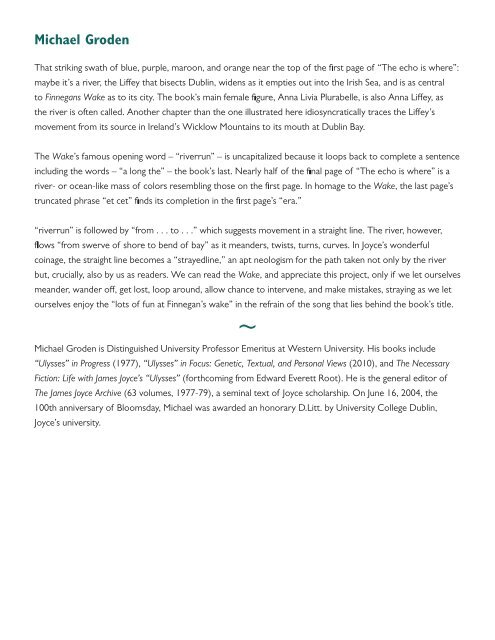The echo is where Peter O'Brien 2019
Create successful ePaper yourself
Turn your PDF publications into a flip-book with our unique Google optimized e-Paper software.
Michael Groden<br />
That striking swath of blue, purple, maroon, and orange near the top of the first page of “<strong>The</strong> <strong>echo</strong> <strong>is</strong> <strong>where</strong>”:<br />
maybe it’s a river, the Liffey that b<strong>is</strong>ects Dublin, widens as it empties out into the Ir<strong>is</strong>h Sea, and <strong>is</strong> as central<br />
to Finnegans Wake as to its city. <strong>The</strong> book’s main female figure, Anna Livia Plurabelle, <strong>is</strong> also Anna Liffey, as<br />
the river <strong>is</strong> often called. Another chapter than the one illustrated here idiosyncratically traces the Liffey’s<br />
movement from its source in Ireland’s Wicklow Mountains to its mouth at Dublin Bay.<br />
<strong>The</strong> Wake’s famous opening word – “riverrun” – <strong>is</strong> uncapitalized because it loops back to complete a sentence<br />
including the words – “a long the” – the book’s last. Nearly half of the final page of “<strong>The</strong> <strong>echo</strong> <strong>is</strong> <strong>where</strong>” <strong>is</strong> a<br />
river- or ocean-like mass of colors resembling those on the first page. In homage to the Wake, the last page’s<br />
truncated phrase “et cet” finds its completion in the first page’s “era.”<br />
“riverrun” <strong>is</strong> followed by “from . . . to . . .” which suggests movement in a straight line. <strong>The</strong> river, however,<br />
flows “from swerve of shore to bend of bay” as it meanders, tw<strong>is</strong>ts, turns, curves. In Joyce’s wonderful<br />
coinage, the straight line becomes a “strayedline,” an apt neolog<strong>is</strong>m for the path taken not only by the river<br />
but, crucially, also by us as readers. We can read the Wake, and appreciate th<strong>is</strong> project, only if we let ourselves<br />
meander, wander off, get lost, loop around, allow chance to intervene, and make m<strong>is</strong>takes, straying as we let<br />
ourselves enjoy the “lots of fun at Finnegan’s wake” in the refrain of the song that lies behind the book’s title.<br />
~<br />
Michael Groden <strong>is</strong> D<strong>is</strong>tingu<strong>is</strong>hed University Professor Emeritus at Western University. H<strong>is</strong> books include<br />
“Ulysses” in Progress (1977), “Ulysses” in Focus: Genetic, Textual, and Personal Views (2010), and <strong>The</strong> Necessary<br />
Fiction: Life with James Joyce’s “Ulysses” (forthcoming from Edward Everett Root). He <strong>is</strong> the general editor of<br />
<strong>The</strong> James Joyce Archive (63 volumes, 1977-79), a seminal text of Joyce scholarship. On June 16, 2004, the<br />
100th anniversary of Bloomsday, Michael was awarded an honorary D.Litt. by University College Dublin,<br />
Joyce’s university.


